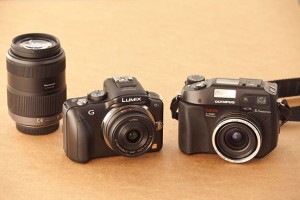Across two decades, I have owned/used three film cameras, two digital cameras, and one video camcorder. Recently, I acquired a new camera to replace my old digital compact. The new camera is a Panasonic Lumix G3.
The G3 is a relatively compact camera with interchangeable lenses. It is half the size of my Canon DSLR. The G3 is a Micro Four-Thirds camera. Because Four-Thirds and Micro Four-Thirds are both open standards (jointly developed by Olympus and Panasonic), the camera can accept lenses from different vendors, such as Olympus, Panasonic, and Leica.
The biggest reason I replaced the old compact camera is poor low-light performance. The old camera had a maximum ISO of 400 and was prone to a good deal of chromatic noise. The new G3 has a maximum ISO of 6400 and the noise is far less than the old camera at ISO 400.
The ability to record images in low-light is largely a matter of the image sensor. Most small cameras employ small image sensors, which perform poorly in low light. In recent years, some small-to-medium size cameras have been employing larger image sensors. The G3 features a Four-Thirds sensor, which is about six times larger than the sensor in the old C-5060 and is half the size of the image sensor in my DSLR. G3 has three times more pixels than the C5060, while the image sensor size is six times larger. So the individual pixels are larger; and, theoretically, larger pixels can take in more light. But this is theory; the proof is the actual image quality.
